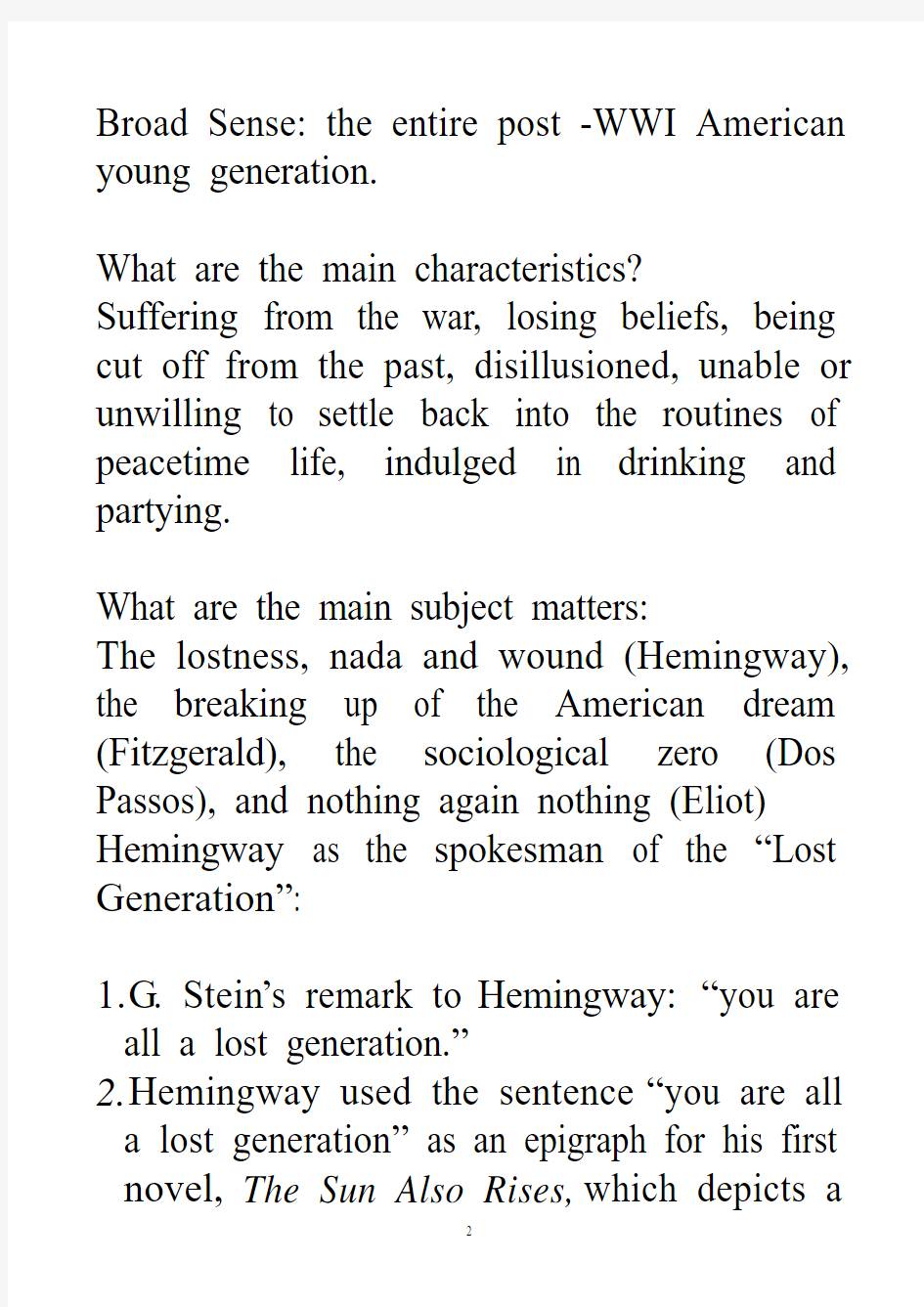About the “Lost Generation ”


About the “Lost Generation ”
What does it Mean?
It defines a sense of moral loss or aimlessness. The WWI destroyed the innocent ideas, many good young men went to the war and died, or returned damaged, both physically and mentally; their moral faith were no longer valid--- they were “Lost.”
Where does it come from?
From Gertrude Stein, an American woman writer, and a French garage owner; “une generation perdue.”
What causes its appearance?
WWI; economic boom; modern philosophy and psychology.
To whom does it refer?
Narrow sense: a group of American writers, including Hemingway, F.S.Fitzgerald, J.Dos Passos, E.E.Cummings, A.Macleish, Sherwood Anderson, and Hart Crane, etc.
Broad Sense: the entire post -WWI American young generation.
What are the main characteristics? Suffering from the war, losing beliefs, being cut off from the past, disillusioned, unable or unwilling to settle back into the routines of peacetime life, indulged in drinking and partying.
What are the main subject matters:
The lostness, nada and wound (Hemingway), the breaking up of the American dream (Fitzgerald), the sociological zero (Dos Passos), and nothing again nothing (Eliot) Hemingway as the spokesman of the “Lost Generation”:
1.G. Stein’s remark to Hemingway: “you are all a lost generation.”
2.H emingway used the sentence “you are all
a lost generation” as an epigraph for his first novel, The Sun Also Rises, which depicts a
“lost generation”of postwar American drifters in France and Spain.
3.A lmost all of Hemingway’s works deal with the disillusionment of “the lost generation”, almost all his heroes are members of “the lost generation.”
4.H emingway is the leader of “the lost generation” in the adaptation of naturalistic technique and many modernistic methods. His novels dramatized the social history of “the lost generation.”
5.I ntimate connection between Hemingway and his heroes: he describes himself when he tells us the story of his heroes; Hemingway, “the lost generation,”and Hemingway’s heroes share common features.
6.H emingway speaks for “the lost generation”through his choice of themes and writing style; his themes focus on “the lost generation”, his style fits for “the lost generation.”
Stream of Consciousness
I.General introduction:
In literature, it is a narrative technique that records the thoughts and feelings of characters with no regard to logical argument or narrative sequence. SOC novel is concerned with mental and spiritual experience such as sensations, memories, imaginations, intuitions, etc.
II.Origin and development
1.W illiam James: coined the term “stream
of consciousness” in his book Principle of Psychology (1890)
“意识本身并非是许多割裂的碎片。乍看起来,似乎可以用“锁链”或“系列”这样的字眼来描述它,这是不恰当的。意识并不是一段一段地联接起来的。用“河”或者“流”这样的比喻来描述它才恰如其分……我们就称之为思想流,意识流或
主观生活之流吧。”
2.Masters of SOC writers: Marcel Proust (French, A La recherche du temps perdu,), James Joyce (Irish, Ulysses,Finnegans Wake ) Virginia Woolf (British, Mrs Dalloway, To the Lighthouse, The Waves), William Faulkner (Amreican,The Sound and the Fury, As I Lay Dying), etc.
III.the background to SOC’s coming into being:
1.h istorical and social background
war effect, loss of faith in Victorian values and God, the need to morbid psychology in
a morbid society.
2.c ultural background
Henry Bergson: French philosopher; theory of time, distinction between exterior time and psychic time.
Sigmund Freud: Austrian psychologist; consciousness is the composition of three parts--- consciousness, preconsciousness, and unconsciousness.
Consciousness--- moral appearance---superego
IV.F eatures (a comparison of traditional
consciousness in a novel:
1.p articular consciousness is a private thing.
2.c onsciousness is never static, but in a state of motion
VI.T echniques and devices to control the movement of consciousness:
1.f ree association
2.i nterior monologue
3.“cinematic”devices: montages,
multiple-view, slow-ups, fade-outs, cutting, close-ups, panorama and flash-backs.
